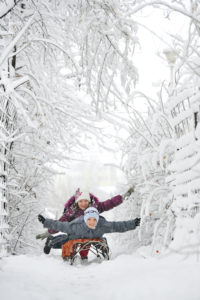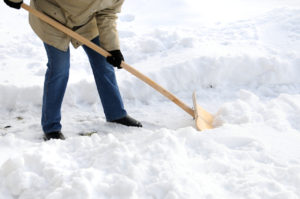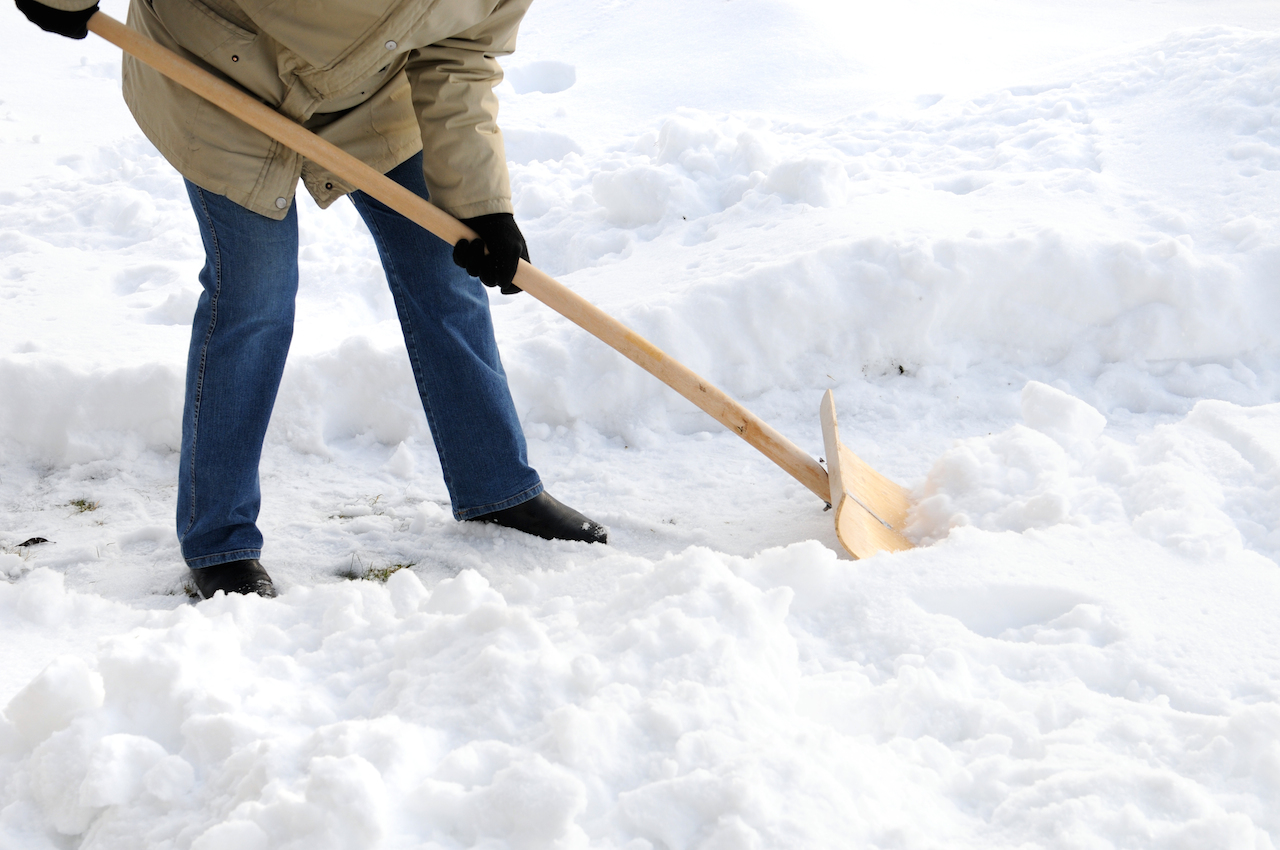Most of us are accustomed to the cold and icy winters in Virginia. However, winter recreational activities and chores can pose a predicament for the outdoor enthusiast whose body is not in condition. Winter activities like shoveling, hiking, skiing, and sledding, can cause painful muscle spasms or strains and tears. Getting around town, clambering awkwardly over snow banks, slipping on sidewalks, and wearing the wrong kind of clothing can lead to spasms, strains, and sprains. In the same way we need the reminder to drive more slowly during the first snowfall, we also need to remember the following tips to get through the snow and cold:
Skiing, Hiking, or Sledding
The American Chiropractic Association (ACA) suggests that you engage in light aerobic activity for 7-10 minutes before participating intensely in these activities. The following are recommendations for a proper warm-up:
Skiing – do 10 to 15 squats. Stand with your legs shoulder width apart, knees aligned over your feet. Slowly lower your buttocks as you bend your knees over your feet. Stand up straight again.
Hiking – do several lunges. Take a moderately advanced step with one foot. Let your back knee come down to the floor while keeping your shoulders in position over your hips. Repeat the process with your other foot.
Sledding – walk in place, with a high knee movement, to reduce compression of the lumbar spine and hips caused by repetitive bouncing over the snow. Stand and bring your knee up to your opposite elbow, alternating sides at a marching tempo. Perform this exercise for 15-30 seconds.
Loosening the hips is key to preventing many low back injuries. Check out our hip mobilization program that we produced for many of our running athletes. This video is a great warm-up program before any activity.
Shoveling
With the first big snowstorm of the year soon to come, this is a timely reminder. Snow is enormous fun for children to play in, but can be a lot of work for adults who have to shovel! Shoveling should be thought of as a workout, especially if you’re not used to regular exercise. As mentioned above, a proper warm up is critical to avoiding injury.
Here are some of our favorite tips to encourage safer shoveling:
- Wise Up – If possible, start shoveling after the first couple of inches fall. Snow is lighter when fresh, and if you can keep on top of it before too much accumulates, you won’t have a heavy mound of packed ice to deal with later.
- Warm up – Perform a few stretches in the house. Warm and loosen those muscles!
- Straighten Up – Focus on keeping your back straight, use your legs to help lift the shovel, and push the snow instead of lifting whenever possible. Don’t twist your body and don’t toss snow over your shoulders.
- Lighten Up – Work at a moderate pace that is comfortable for you. Do not try to lift too much snow at one time.
- Rest Up, Drink Up, and Layer Up –Take frequent breaks, drink warm to hot water to stay well-hydrated, and dress in layers so that you can subtract and add clothing as you heat up and cool down again.
- Sun Up – If the sun is out, do not be too worried about thoroughness. Even on a very cold day, the strong rays will speed the snow’s thaw and melt any remaining patches you leave behind.
- Wind Down – Do some gentle stretches when you are finished, drink more water, and if muscles are sore, enjoy a hot salt bath!
- Stop- if you feel chest pain, or get really tired or experience shortness of breath, STOP! You may need immediate professional help.
Vitamin D
Your production of vitamin D is greatly reduced during winter months due to the short daylight hours and limited skin exposure when outside. Your body essentially stops producing vitamin D and relies on stored supplies of vitamin D from the summer months. Low vitamin D levels can cause several symptoms including fatigue, aches and pains, and even feeling sad and/or depressed. If you are experiencing any of these symptoms, it may be a sign that you need to increase your vitamin D intake.
Slip and Fall Prevention
Slipping on ice can cause fractures and even more serious injuries like concussions. During the winter, these types of injuries are among the most common that occur with thousands ending in hospital visits. We don’t want you to be part of that statistic.
Preparation is key
Slippery ice while getting to work or dropping the kids off at school on time do not mix well. Understanding preventative measures and preparing for tricky walking conditions is key. Follow these tips for a slip-free, and therefore stress-free, morning:
1) Leave plenty of time so you aren’t rushing. You’ll be able to focus more on walking and taking careful steps if you aren’t pressed for time. If you have children, educate them on the dangers of walking on ice and get them on board with preparations that allow for a timely departure.
2) Wear slip resistant shoes (with rubber soles) or ice cleats. Invest in proper footwear for the snow and ice. Anything with smooth or leather soles is going to cause you to slip and slide. Yaktrax, Stabilicers, and Kahtoola are just a few highly rated brands for ice cleats.
3) Walk on designated walkways. Don’t try to shortcut your path when the walking conditions are dangerous. We love innovation, but when there is ice on the ground it’s best to keep to the path most traveled.
4) Walk flat-footed and center your gravity over your feet. This will keep you stable and help you balance. Don’t forget to move slowly with your steps.
5) Don’t put your hands in your pockets. You’ll have a lower center of gravity and better balance if your hands are out and your arms are at your sides. Low center of gravity will stabilize your movement.
6) Use handrails and your car door for support. Two of the trickiest walking situations are steps and getting in and out of your car. In both situations, there is a moment when only one foot is on the ground. Take advantage of your surroundings for balance.
7) Place your full attention on walking. Don’t get distracted by your cell phone and prepare your children before you make your way to the car.
What should you do after you fall?
After taking a tumble, your injury might be obvious. In many cases, however, you might not notice problems and pains until weeks or even months later when the lower back pain starts. If you fell and aren’t experiencing any pain at the moment, it’s a good idea to get yourself to your chiropractor immediately. They’ll be able to spot any problems early and take corrective action and assess your next move.
Stay Healthy and Warm!
If you experience back pain or muscle soreness after any winter activities, it may be beneficial to see a chiropractic physician. At [Core] Chiropractic, we use a variety of tools to get you back to health. Chiropractic manipulation is useful to help stiff and achy joints move more freely. Active Release Technique is fantastic at breaking up old scar tissue and increasing range of motion. Acupuncture can reduce pain caused by traumatic or repetitive injury. And don’t forget our wide array of supplements to reduce aches and pain: Curcumin, Biofreeze, Glucosamine/Chondroitin, and essential oils can all be helpful. Call our Roanoke, Virginia office at: 1-540-344-1055 to ask Dr. Rich if any of these could be useful for your unique condition.
End of Year Sale!
15% Off All Vitamins and Supplements, Pillows, Oils, and Diffusers!
Thru Dec. 31st

Dr. Daryl Rich, DC, CSCS





